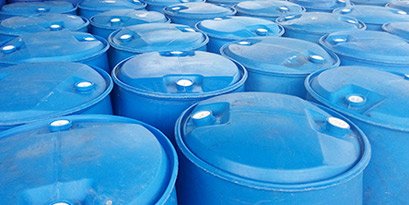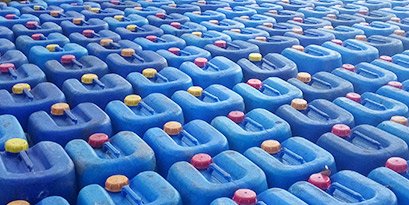Aqueous Ammonia (Liquor Ammonia)
Ammonia in Water, commonly known as Aqua Ammonia renders it safe to handle and helps avoid the hazards that accompany use of Ammonia Gas by greatly reducing its vapour pressure. Also known as Ammoniacal Liquor, it is an inorganic chemical used as a liquid chemical in various industries like Rubber, Pharmaceuticals among others. Sometimes called Ammonium Hydroxide, the chemical formula is NH4OH with UN No. 2672 and CAS registry is 1336-21-6.
Commonly manufactured with a concentration of about 25% w/w, Ammonia Hydroxide Solution is supplied in varying Packaging capacities ranging from 5 Lt. To 235 Lt. HMHDPE Plastic containers, 6 MT to 15 MT Tankers and 22 MT ISO Tankers.


Aqueous Ammonia - Specifications
| Aqueous Ammonia Solution (Ammonium Hydroxide) | |
| Description | A Clear Colorless Liquid Odor Strongly Pungent & Characteristic |
| Solubility | Mixable with water in all Proportions |
| Identifications | I.P.Identification test for ammonia positive |
| Residue On Evaporation | 0.0068 % |
| Specific Gravity @ 25 c | 0.905 gms |
| Chloride (AS CL) | Less than 0.0005 % |
| Sulphate (AS SO4) | Less than 0.0002 % |
| Iron (AS Fe) | Less than 0.00002 % |
| Carbonate (AS CO3) | Less than 0.002 % |
| Assay | Contents of Ammonia i.e NH3 = 25 % @ 27 C Contents of Water 75 % |
Liquor Ammonia conforms to IS : 799 - 1985
Aqueous Ammonia - Safety Data
First Aid For Ammonia Solution (NH4OH)
Emergency Overview
POISON! DANGER! CORROSIVE. MAY BE FATAL IF SWALLOWED OR INHALED. MIST AND VAPOR CAUSE BURNS TO EVERY AREA OF CONTACT.
SAF-T-DATA(tm) Ratings (Provided here for your convenience)
- Health Rating: 3 - Severe (Poison)
- Flammability Rating: 0 - None
- Reactivity Rating: 1 - Slight
- Contact Rating: 4 - Extreme (Corrosive)
- Lab Protective Equip: GOGGLES & SHIELD; LAB COAT & APRON; VENT HOOD; PROPER GLOVES
- Storage Color Code: White Stripe (Store Separately)
Potential Health Effects
InhalationVapors and mists cause irritation to the respiratory tract. Higher concentrations can cause burns, pulmonary edema and death. Brief exposure to 5000 ppm can be fatal.
IngestionToxic! May cause corrosion to the esophagus and stomach with perforation and peritonitis. Symptoms may include pain in the mouth, chest, and abdomen, with coughing, vomiting and collapse. Ingestion of as little as 3-4 mL may be fatal.
Skin ContactCauses irritation and burns to the skin
Eye ContactVapors cause irritation. Splashes cause severe pain, eye damage, and permanent blindness
Chronic ExposureRepeated exposure may cause damage to the tissues of the mucous membranes, upper respiratory tract, eyes and skin.
Aggravation of Pre-existing ConditionsPersons with pre-existing eye disorders or impaired respiratory function may be more susceptible to the effects of this material.
First Aid Measures
InhalationRemove to fresh air. If not breathing, give artificial respiration. If breathing is difficult, give oxygen. Call a physician immediately.
IngestionIf swallowed, DO NOT INDUCE VOMITING. Give large quantities of water. Never give anything by mouth to an unconscious person. Get medical attention immediately.
Skin ContactImmediately flush skin with plenty of water for at least 15 minutes while removing contaminated clothing and shoes. Call a physician, immediately. Wash clothing before reuse.
Eye ContactImmediately flush eyes with gentle but large stream of water for at least 15 minutes, lifting lower and upper eyelids occasionally. Call a physician immediately. Immediate action is critical to minimize possibility of blindness.
Fire Fighting Measures
FireAutoignition temperature: 651C (1204F) Flammable limits in air % by volume: lel: 16; uel: 25
ExplosionFlammable vapors may accumulate in confined spaces
Fire Extinguishing MediaUse any means suitable for extinguishing surrounding fire. Use water spray to blanket fire, cool fire exposed containers, and to flush non-ignited spills or vapors away from fire
Special InformationIn the event of a fire, wear full protective clothing and NIOSH-approved self-contained breathing apparatus with full facepiece operated in the pressure demand or other positive pressure mode.
Accidental Release Measures
Ventilate area of leak or spill. Keep unnecessary and unprotected people away from area of spill. Wear appropriate personal protective equipment as specified in Section 8. Contain and recover liquid when possible. Do not flush caustic residues to the sewer. Residues from spills can be diluted with water, neutralized with dilute acid such as acetic, hydrochloric or sulfuric. Absorb neutralized caustic residue on clay, vermiculite or other inert substance and package in a suitable container for disposal.
US Regulations (CERCLA) require reporting spills and releases to soil, water and air in excess of reportable quantities. The toll free number for the US Coast Guard National Response Center is (800) 424-8802.
Handling and Storage
Keep in a tightly closed container, stored in a cool, dry, ventilated area. Protect against physical damage. Separate from incompatibilities. Store below 25C. Protect from direct sunlight. Containers of this material may be hazardous when empty since they retain product residues (vapors, liquid); observe all warnings and precautions listed for the product.
Exposure Controls/Personal Protection
Airborne Exposure Limits:- OSHA Permissible Exposure Limit (PEL): 50 ppm (NH3)
- ACGIH Threshold Limit Value (TLV): 25 ppm (NH3) (TWA) 35 ppm (STEL)
A system of local and/or general exhaust is recommended to keep employee exposures below the Airborne Exposure Limits. Local exhaust ventilation is generally preferred because it can control the emissions of the contaminant at its source, preventing dispersion of it into the general work area. Please refer to the ACGIH document, Industrial Ventilation, A Manual of Recommended Practices, most recent edition, for details.
Personal Respirators (NIOSH Approved)If the exposure limit is exceeded and engineering controls are not feasible, a full facepiece respirator with an ammonia/methylamine cartridge may be worn up to 50 times the exposure limit or the maximum use concentration specified by the appropriate regulatory agency or respirator supplier, whichever is lowest. For emergencies or instances where the exposure levels are not known, use a full-facepiece positive-pressure, air-supplied respirator. WARNING: Air purifying respirators do not protect workers in oxygen-deficient atmospheres.
Skin ProtectionWear impervious protective clothing, including boots, gloves, lab coat, apron or coveralls, as appropriate, to prevent skin contact. Neoprene and nitrile rubber are recommended materials. Polyvinyl alcohol is not recommended.
Eye ProtectionUse chemical safety goggles and/or full face shield where dusting or splashing of solutions is possible. Maintain eye wash fountain and quick-drench facilities in work area.
Aqueous Ammonia - Applications
-

Rubber
-

Leather
-

Plastics
-

Electronics
-

Food &
Beverage -

Pulp &
Paper -

Water &
Waste Water
Treatment -

Agriculture
-

Chemicals,
Pharmaceuticals
& Biotechnology